How and what to feed roses in July for lush bloom
The queen of garden flowers - a lush and fragrant rose - needs in careful care and regular feeding. The composition of nutritional mixtures should include micro and macro elements: nitrogen, phosphorus, potassium, calcium, magnesium, manganese, sulfur. How to feed roses in July and what fertilizers are necessary for abundant flowering, we will tell in the article.
The content of the article
Do roses need feeding in July
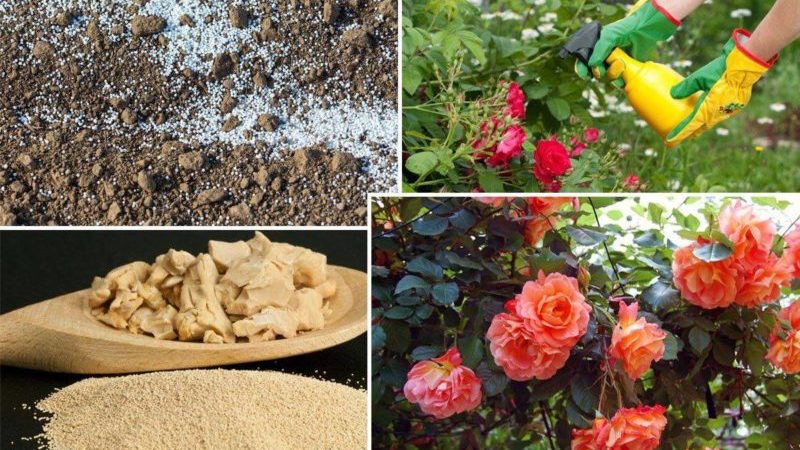
All varieties of garden roses need feeding throughout the season, but not more than 2 times a month. In summer, buds are laid, and the rose especially needs potassium and magnesium. For lush flowering, top dressing is applied both by root and foliar methods.
On sparse soils in early - mid-July, flowers are fed with mineral compounds. A particular danger is nitrogen, which provokes a set of green mass. Instead of a blooming rose garden, there is a risk of getting a sprawling bush with lush foliage and no buds. Nitrogen stimulates the development of new shoots and inhibits the maturation of wood, as a result of which the winter hardiness of the flower decreases.
Important! It is recommended to exclude nitrogen from 15-20 July. Its excess leads to the development of powdery mildew and slow lignification of the shoots.
What fertilizing does a rose need in July
The composition of summer dressings for roses should include micro and macro elements. Without them, the flower loses its ability to develop and bloom normally. Nutritional deficiency leads to deformation, drying out, loss of color of leaves, crushing of buds, partial or complete absence of them.
List of essential elements for roses:
- Nitrogen is responsible for the health and vibrancy of shoots and foliage.
- Phosphorus is necessary for the plant to form buds.
- Potassium helps the plant absorb phosphorus.
- Calcium is responsible for the development of the root system.
- Magnesium contributes to the synthesis of chlorophyll.
- Manganese, iron, zinc, copper improve the metabolism of the plant, increase the flowering period.
Symptoms and consequences of deficiency and excess of substances are presented in the table.
| Nutrient | Deficit | Excess |
| Nitrogen | Pale color of leaves, red spots, premature fall. Shortened shoots, weak flowering, incomplete maturation of the wood. | Dark green foliage, fast green mass gain, soft stems, development of fungal diseases. |
| Phosphorus | Dark green color of leaves with a purple or red tint, brown-violet stripes at the edges and spots on the back of the leaf plate. Lilac petioles and stems, weak shoots. Delayed flowering. | Salting of the soil, metabolic disorders, indigestion of iron and copper. |
| Potassium | Yellow leaves with green veins, dry edges. Change from yellow to red-violet. Small buds, young leaves are red with brown edges. Blackening and dying off of the lower leaves. | Delayed growth and development of the bush. |
| Calcium | Weak stems, dry tops of young leaves, death of peduncles. | Delayed root development. |
| Iron | Yellow edges of the leaf blade, a narrow green strip along the vein on a completely yellow leaf, discolored small veins. Gradually, the leaves become white-cream. | Pale leaves and shoots. |
| Magnesium | Colorless spots on the leaves, dark red areas between the veins, dead zones of red-yellow color, while the edges of the leaf plate remain green. | Delayed absorption of potassium. |
| Sulfur | Light green leaves, red spots. | An excess is usually not observed. |
Timing
Roses are fed strictly after flowering 2-3 times a month.Some gardeners prefer to follow the phases of the moon.
In 2020, the most favorable dates for feeding are considered:
- dry and liquid fertilizers: 2-3, 6-7, 11-19, 29-30 July;
- exclusively dry fertilizers: July 9-10, 16-17, 25-26.
Auspicious days in 2021:
- dry and liquid fertilizers: 4-7, 13-17, 19-22, 27-28, 31 July;
- exclusively dry fertilizers: 1-3, 11, 18, 24-25, 29-30.
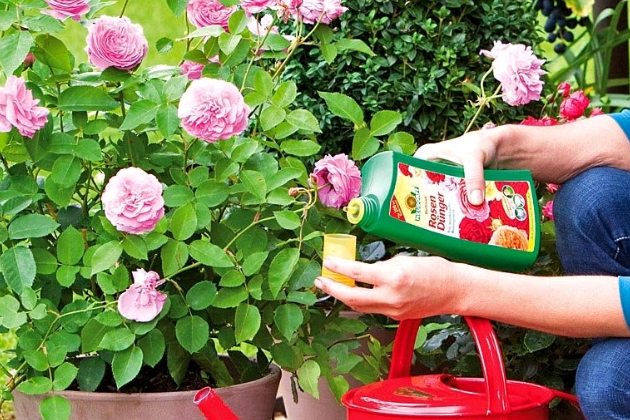
How to feed
Mineral fertilizers are produced in the form of powder, granules, tablets, solutions. Organic matter is introduced in liquid form and combined with minerals. The combination of both types allows you to achieve maximum results.
Mineral fertilizers
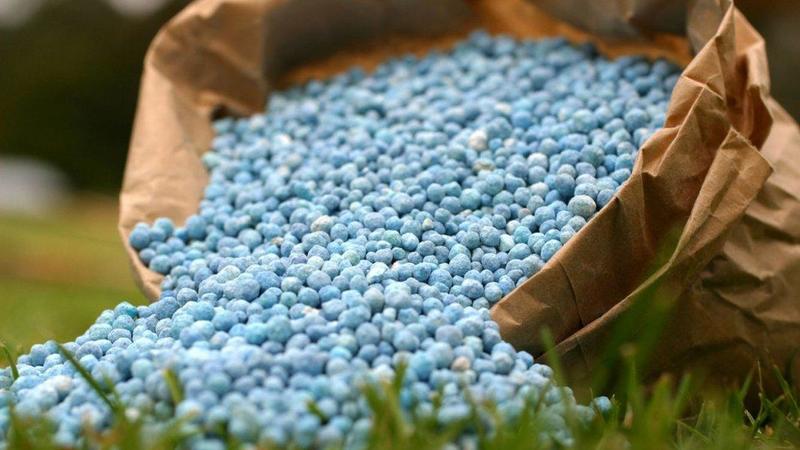
On sale there are special fertilizers with nitrogen, phosphorus and potassium in the optimal dosage. The products of such companies have proven themselves to be excellent: Gardena, Pokon, Agricola-Aqua, BioEcor, Gloria (granules with magnesia), Hera (potassium humate and trace elements), Spezial-Rozendunger.
After flowering, the roses are fertilized with universal complexes with potassium and phosphorus ("Kemira universal") together with an infusion of mullein or bird droppings.
Nitrogen is especially effective and useful for growing green mass in early July. To prepare a solution for 10 liters of water, take 1 tbsp. l. urea or ammonium nitrate. Top dressing is applied once in early July.
Potassium and phosphorus are added in the complex once during the budding period. The most popular food for all flowering plants:
- superphosphate (30 g per 10 l of water);
- potassium sulfate, potassium magnesium (30 g per 10 liters of water).
With a calcium deficiency, the bushes are fed with calcium nitrate (25-30 g per 10 liters of water). The drug "Kemira Universal 2" will help to compensate for the calcium deficiency (30 g per 10 liters of water).
Mineral fertilizer "Gloria" in granules has a prolonged action and contains magnesium and calcium. Fertilizer is spread evenly over the soil for digging.
Fertilizer Bona Forte in liquid form is poured into plastic canisters. It contains magnesium, succinic acid, microelements in a chelated form. Flowers are fertilized from early spring to mid-July once with a break of 10-15 days.
It is interesting:
How to care for a home potted rose - a beginner's guide
A guide to cutting roses in the fall at home for beginner florists
How to protect bushes and how to treat roses in spring from diseases and pests
Organic compounds
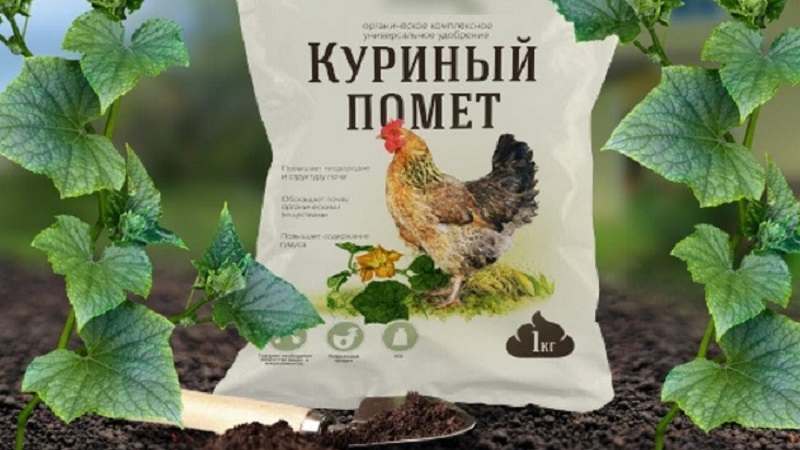
Organic fertilizers are prepared independently. These are the same folk remedies, the components for which are always at hand at the gardener: compost, manure, peat, green fertilizer.
Council. Do not use fresh manure to feed roses, it burns the root system of the plant. Take rotted manure instead.
Organic dressing recipes:
- 2.5-3 liters of chicken manure per 50 liters of water. The mixture is infused under the lid for 4-6 days, then diluted with water 1:10. Before use, 30 g of superphosphate and 500 g of ash are added to the solution. For watering in 10 liters of water, dilute 3 liters of infusion.
- 5 liters of manure, 500 g of superphosphate, 500 g of ash per 50 liters of water. The mixture is infused for a week. For irrigation, 5 liters are diluted in 10 liters of water.
- The barrel is 80% filled with fresh mullein and filled to the brim with water. For every 10 liters, add 100 g of ash. The mixture is infused for 14 days, stirring occasionally. Before use, 30 g of superphosphate, potassium sulfate or potassium magnesium sulfate are mixed into the infusion.
- For 10 liters of water, take 100 g of wood ash for irrigation and 200 g for 10 liters for spraying foliage. During use, the solution is constantly stirred to obtain a suspension.
- Fresh nettle is tightly folded into a bucket with a capacity of 10 liters, together with the roots, 100 g of superphosphate, 200 g of ash are added, poured with water and insisted for a week. To speed up the process, the bucket is left in the sun. For irrigation, an unstrained infusion (1 l / 10 l) is used; for spraying, it is filtered and diluted before use (0.5 l / 10 l).
The slurry is introduced into the soil, and the mineral compositions are added to the foliage, reducing the dosage by 3 times.
How to fertilize for lush flowering in the garden
In July, rosebuds form, so during this period the plant needs potassium-magnesium dressings. For abundant and long-lasting flowering, gardeners use:
- superphosphate (30 g per 10 l);
- sodium humate in the finished complex fertilizers ("Hera");
- ammonium nitrate (30 g per 10 l);
- potassium magnesium (30 g per 10 l).
Many gardeners use folk recipes: a solution of horse manure or mullein mixed with wood ash, nettle infusion.
Before and during the budding period, the bushes are fed with a mixture of potassium sulfate and superphosphate in a ratio of 30: 100 per 10 liters of water. After watering, a solution of mullein and herbal infusion based on nettle is introduced into the soil. Then the soil is carefully mulched with rotted cow dung. The mulch should not come into contact with branches and leaves.
The choice of feeding in the middle lane
When growing roses in the climate of central Russia, foliar dressing is especially effective. Nutrients applied to foliage quickly penetrate plant tissues even with a lack of sunlight and low soil temperatures.
The composition is applied using a spray bottle in the evening or in cloudy weather. Top dressing is not applied at the slightest sign of fungal diseases and during the flowering period.
In the Urals
During the budding period, rose bushes are fertilized with complex mineral compositions based on phosphorus and potassium (potassium monophosphate, double superphosphate). To stimulate flowering and increase the diameter of flowers, use special preparations ("Bud") or agents based on gibberellic acid.
Spraying is performed after the appearance of young shoots in early July. To prepare the solution, take 2 g of the stimulant per 1 liter of warm water.
In Siberia
In Siberia, top dressing is applied from June to July. In late May - mid-July, rose bushes are fed:
- mullein solution 1:15 or chicken droppings 1:20, when the shoots reach 10 cm in height;
- complex mineral fertilizers during the first budding period.
In August, fertilizers are not applied, since additional feeding provokes a re-set of green mass and negatively affects winter hardiness.
How to feed roses
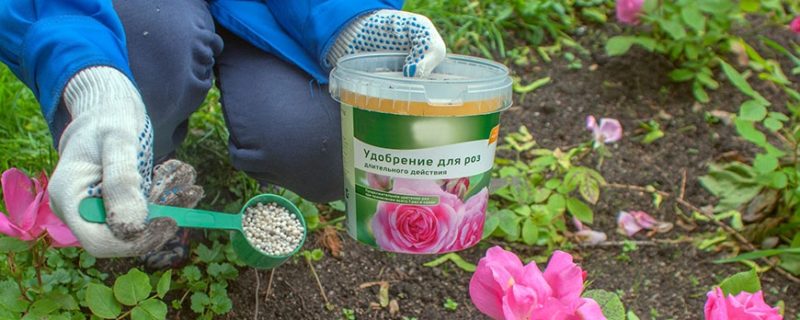
Fertilizers for garden roses are applied in two ways: root and foliar. Each of them has its own characteristics. To determine which one is best for roses, gardeners recommend trying both and assessing the result. It all depends on the growing conditions, soil type and climate characteristics.
Root dressing is applied immediately after watering or rain, so as not to burn the roots. For foliar procedures, herbal infusions are often used. Rose bushes are sprayed in the evening or in cloudy weather so that the nutrient composition does not evaporate under the influence of sunlight.
In a root way
Root dressings applied directly to the soil, dry or wet, are considered the most effective. A shallow trench with a radius of 15 cm is dug around the stem. Top dressing mixed with turf is placed in it and covered with soil. When watering, fertilizers dissolve and penetrate deeply into the soil, gradually saturating it with nutrients.
Foliar
Foliage dressing is applied when the plant is weakened or the weather conditions are not the most favorable. The composition is applied with a spray until the foliage is completely wetted. Processing is performed on both sides.
The composition of foliar fertilizers should include micro and macro elements. Nitrogen and potassium dissolve perfectly in cold water, so it is convenient to prepare solutions immediately before spraying. Superphosphate is infused in water at room temperature for a day. Foliar dressing is recommended in dry, but not hot weather.
Nutrient Solution Recipes:
- 30 g of urea per 10 liters of water (for the prevention of fungal diseases and insect attacks);
- Insist 10 g of sodium humate per 3 liters of hot water for 10 hours, then prepare a working solution with the addition of water (250 ml of concentrate per 5 liters of water);
- 50 g of superphosphate per 1 liter of hot water, leave for 3-4 hours, strain, dilute in 10 liters of water, add 20 g of potassium nitrate before processing the bushes;
- 10 g magnesium sulfate per 10 liters of water;
- 25 g of calcium nitrate per 10 liters of water.
Foliar dressing is applied immediately after mixing. They do not salt the soil, do not destroy beneficial microorganisms and earthworms. Foliar dressing should not be done on wet foliage, in cold, rainy weather, or on a day when heavy dew is expected. Foliar feeding on leaves with foci of black spot is especially dangerous.
Experienced gardening tips

Tips from experienced florists to help maintain the beauty and health of your garden rose garden in summer:
- Before feeding roses during flowering and budding, pay attention to the fact that feeding can only be applied at the stage of active bud formation. During the flowering period, the procedure is not carried out. Apply organics and minerals after flowering.
- Soak superphosphate in hot water, the granules dissolve poorly in cold water.
- Roses respond with gratitude to nitrogen fertilization, but try to observe the measure and completely eliminate this trace element from mid-June.
- A solution based on pressed yeast is an excellent top dressing that always helps in the absence of a ready-made solution with trace elements. Dissolve 1 kg of fresh yeast in 10 liters of warm water, and dilute 1:10 with water before use. Pour 1 liter under each bush.
- Leave the rotted manure for digging in the fall, and in July, under each bush, pour in a solution prepared from 1 kg of bird droppings and 10 liters of water once.
- Use wood ash when growing roses in acidic soils. The solution prolongs the flowering period and saturates the roses with additional trace elements.
- Alternate organics and minerals for better nutrient absorption.
Conclusion
For lush and abundant flowering, the rose needs organic and mineral fertilizers. When using them, it is important to remember that root and foliar dressings are applied either during the budding period or after flowering.
Nitrogen fertilizing is applied until mid-July, then completely stopped. An excess of nitrogen provokes a set of green mass, stops lignification, thereby impairing the winter hardiness of the plant. Minerals such as potassium, magnesium, phosphorus are responsible for the bright color of leaves and flowers. Manganese, iron, zinc, copper lengthen the flowering period.
